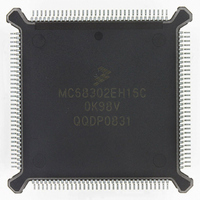MC68302EH16C Freescale Semiconductor, MC68302EH16C Datasheet - Page 368

MC68302EH16C
Manufacturer Part Number
MC68302EH16C
Description
IC MPU MULTI-PROTOCOL 132-PQFP
Manufacturer
Freescale Semiconductor
Datasheets
1.MC68302AG20C.pdf
(4 pages)
2.MC68302AG20C.pdf
(2 pages)
3.MC68302AG20C.pdf
(13 pages)
4.MC68302EH16C.pdf
(481 pages)
Specifications of MC68302EH16C
Processor Type
M683xx 32-Bit
Speed
16MHz
Voltage
5V
Mounting Type
Surface Mount
Package / Case
132-MQFP, 132-PQFP
Controller Family/series
68K
Core Size
32 Bit
Ram Memory Size
1152Byte
Cpu Speed
16MHz
No. Of Timers
3
Embedded Interface Type
SCP, TDM
Digital Ic Case Style
PQFP
Rohs Compliant
Yes
Family Name
M68000
Device Core
ColdFire
Device Core Size
32b
Frequency (max)
16MHz
Instruction Set Architecture
RISC
Supply Voltage 1 (typ)
5V
Operating Temp Range
0C to 70C
Operating Temperature Classification
Commercial
Mounting
Surface Mount
Pin Count
132
Package Type
PQFP
Lead Free Status / RoHS Status
Lead free / RoHS Compliant
Features
-
Lead Free Status / Rohs Status
RoHS Compliant part
Electrostatic Device
Available stocks
Company
Part Number
Manufacturer
Quantity
Price
Company:
Part Number:
MC68302EH16C
Manufacturer:
Freescale Semiconductor
Quantity:
135
Company:
Part Number:
MC68302EH16C
Manufacturer:
PANA
Quantity:
99
Company:
Part Number:
MC68302EH16C
Manufacturer:
Freescale Semiconductor
Quantity:
10 000
Part Number:
MC68302EH16C
Manufacturer:
FREESCALE
Quantity:
20 000
Company:
Part Number:
MC68302EH16CB1
Manufacturer:
Freescale Semiconductor
Quantity:
10 000
Company:
Part Number:
MC68302EH16CR2
Manufacturer:
Freescale Semiconductor
Quantity:
10 000
- MC68302AG20C PDF datasheet
- MC68302AG20C PDF datasheet #2
- MC68302AG20C PDF datasheet #3
- MC68302EH16C PDF datasheet #4
- Current page: 368 of 481
- Download datasheet (2Mb)
MC68302 Applications
initialization corresponds to the recommended order described in 4.5.7 SCC Initialization.
The second part is a set of loops waiting for data to arrive to be retransmitted out of the
SCC3. The third part is the SCC3 receive interrupt handler. Transmit interrupts are masked
in this example.
D.4.2 Organization of Buffers
In the MC68302, there is no such thing as an receive register (Rx) or transmit register (Tx).
Rather, a flexible structure called a buffer descriptor (BD) is used. In this example, two Rx
BDs and two Tx BDs are used. Each BD is set up to point to a one-byte location for data.
Thus, the receiver and transmitter are double-buffered. The number of Rx or Tx BDs can be
changed simply by changing the number of BDs initialized in the code (and two other lines
documented in the code). However, using at least two BDs has advantages as noted in the
following paragraphs.
The structure of the buffers is shown in Figure D-6.
To make the application more general, the data buffers were located in external RAM; how-
ever, internal RAM could have been used. Each BD points to just one byte in memory as
shown. Note that the data buffers do not need to be consecutive as shown.
From one to eight BDs may be used for both the transmit and receive operation. Use of eight
BDs for the transmit side of SCC3 requires that the SCP and SMCs not be used. As data
rates increase substantially beyond the 9600 baud of this example, the use of more BDs and
more data bytes per BD becomes justified. Why were two Rx BDs and two Tx BDs chosen
rather than just one each?
D-18
MC68302
Figure D-6. Transmit and Receive BD Tables and Buffers
A2
A0
ONLY 2 OF 8 BDS ARE USED.
SCC3 TRANSMIT BD TABLE
SCC3 RECEIVE BD TABLE
RX BD 0
RX BD 1
TX BD 0
TX BD 1
MC68302 USER’S MANUAL
THESE POINTERS TO KNOW
WHERE TO STORE DATA.
A1
ON-CHIP DMA USES
DATA BUFFERS IN RAM
BYTE
BYTE
BYTE
BYTE
$30002
$30000
$30001
$30003
CPU MOVES
DATA FROM
RX TO TX
BUFFERS IN
THIS CODE.
MOTOROLA
Related parts for MC68302EH16C
Image
Part Number
Description
Manufacturer
Datasheet
Request
R
Part Number:
Description:
Manufacturer:
Freescale Semiconductor, Inc
Datasheet:

Part Number:
Description:
MC68302 Configuring the Chip Selects on the MC68302
Manufacturer:
Motorola / Freescale Semiconductor

Part Number:
Description:
MC68302 Design Concept - Expanding Interrupts on the MC68302
Manufacturer:
Motorola / Freescale Semiconductor

Part Number:
Description:
MC68302 MC68302 Adapting a WAN Controller to a LAN Environment
Manufacturer:
Motorola / Freescale Semiconductor

Part Number:
Description:
MC68302 EKB Applications - Power Measurements on the MC68302
Manufacturer:
Motorola / Freescale Semiconductor

Part Number:
Description:
MC68302 Interfacing the MC68020 to a Slave MC68302
Manufacturer:
Motorola / Freescale Semiconductor

Part Number:
Description:
MC68302 MC68302 Software Performance
Manufacturer:
Motorola / Freescale Semiconductor

Part Number:
Description:
MC68302 Evaluating EDX on the ADS302
Manufacturer:
Motorola / Freescale Semiconductor

Part Number:
Description:
MC68302 Design Advisory #1 - MC68SC302 Passive ISDN Protocol Engine
Manufacturer:
Motorola / Freescale Semiconductor

Part Number:
Description:
MC68302, MC68360, and MPC860 Characteristics and Design Notes for Crystal Feedback Oscillators
Manufacturer:
Motorola / Freescale Semiconductor
Part Number:
Description:
Mc68302 Integrated Multi-protocol Processor
Manufacturer:
Freescale Semiconductor, Inc
Datasheet:
Part Number:
Description:
Manufacturer:
Freescale Semiconductor, Inc
Datasheet:
Part Number:
Description:
Manufacturer:
Freescale Semiconductor, Inc
Datasheet:
Part Number:
Description:
Manufacturer:
Freescale Semiconductor, Inc
Datasheet:
Part Number:
Description:
Manufacturer:
Freescale Semiconductor, Inc
Datasheet:











